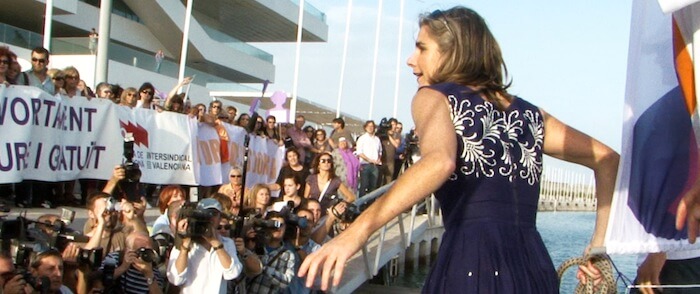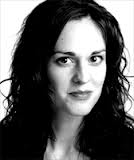

Abortion
Has Abortion Been Cast Out to Sea?
“Vessel,” a new, must-see documentary, introduces activist Dr. Rebecca Gomperts, who has found a unique way to provide safe, legal abortions for those without access.
This article was made possible because of the generous support of DAME members. We urgently need your help to keep publishing. Will you contribute just $5 a month to support our journalism?
In 2007, filmmaker Diana Whitten flew to Amsterdam with a rented camera and did her first-ever video interview with Dr. Rebecca Gomperts, the activist behind Women on Waves, an organization that provides abortions in the safe space of international waters, just off the shores of countries where the procedure is outlawed. “She probably thought we would do an interview and go away,” says Whitten. “Eight years later, here we are.” And here is Vessel, Whitten’s documentary that follows Gomperts, a tenacious and creative activist, and her fight for reproductive rights around the world from Ireland to Poland, where the ship is welcomed by an angry mob screaming “Nazis,” to Ecuador and Tanzania. Over the course of the documentary, Gomperts fortifies her efforts on the high seas with Women on Web, which helps disseminate misoprostol, a pill that induces miscarriages, to desperate women, in hopes of saving some of the 47,000 who die every year from complications of unsafe pregnancy terminations. Whitten spoke to DAME about her riveting film, which premiered at SXSW and is now available on iTunes and VOD.

I was in a master’s program at the New School studying international studies. I was researching offshore spaces and reading about how they’ve been occupied historically for criminal activity and purposes of personal gain. Women on Waves was one of the first examples that really struck me as that space being occupied with a social justice agenda. My emotional attraction to their work definitely grew as I continued to follow them over the years and became more aware of the need for what they do and the dedication of how they do it.
For me it was the landscape here in the United States. That landscape has changed so dramatically. When I first started this film I conceived of it as a foreign story, and since the 2011 Congress, there’s just such a concentrated attack on reproductive rights here in the states that the film is now actually a local story. And what we’re seeing is women with no access to clinical care have to resort to the same solutions, the same use of misoprostol, that women are resorting to around the world where they don’t have any laws that protect their access. Women on Web gets an extraordinary amount of requests from American women, but they don’t work in the U.S. because we have Roe v. Wade—supposedly. It’s a cautionary tale. If we’re not vigilant, that’s what we can expect.
Yes, I hadn’t heard of the abortion pill before I started working on this film and there’s been an increased awareness of it over the past eight years both because there’s been an increased need for it here but also because the medical world has done so much research on it. If you look at the history of the birth control pill, the reason why it was eventually normalized is because knowledge about it reached a critical mass. And I think that’s one tactic to take with medical abortion.
A major concern of mine was to maintain their privacy, so if the camera was making anyone feel uncomfortable it went off. We knew we needed their stories, we knew they needed their voice so that’s why we experimented with how to portray the telephone calls that were coming into the hotlines, and the emails that were coming into the help desk.
Thousands, actually. I was very emotional that week. It was intense, not only just the number of women that write to them, but the back and forth that happens. A lot of these exchanges are in real time as women are taking the pills so there’s all the build up logistically to get them the pills and then there’s the actual experience of miscarrying, which, when you’re alone, can be quite emotional and scary. The back and forth with the volunteers is so hands on and can last hours.
Rebecca thrives in those situations; I think she’s one of those special people that can be at her best when she’s up against a lot. I often found adrenaline kicking in when I was filming those situations and perhaps had a naive understanding that the camera would be some kind of shield between me and anyone who might want to do me harm, because if they did, I could just film them. It never really came to that, at least in the experience of filming. We did have an attack on a screening of the film recently in Sweden. There were three masked men who threw a smoke bomb into the theater and trapped the audience inside. Everyone got out fine, thank goodness, but it was frightening.
I think I’m more idealistic than that. I think there are so many innovative people thinking creatively about this, I think history’s on our side, technology’s on our side, the medical abortion opens up all kinds of new ways of thinking about direct access cause it’s a paradigm shifter. I’m hopeful. I mean, we have to be, otherwise how do you get up in the morning?
If you’d like to screen the film as part of Vessel’s campus and community screening tour, get in touch through vesselthefilm.com. Sign up for the social action network to find out about online and locally based outreach initiatives.
Before you go, we hope you’ll consider supporting DAME’s journalism.
Today, just tiny number of corporations and billionaire owners are in control the news we watch and read. That influence shapes our culture and our understanding of the world. But at DAME, we serve as a counterbalance by doing things differently. We’re reader funded, which means our only agenda is to serve our readers. No both sides, no false equivalencies, no billionaire interests. Just our mission to publish the information and reporting that help you navigate the most complex issues we face.
But to keep publishing, stay independent and paywall free for all, we urgently need more support. During our Spring Membership drive, we hope you’ll join the community helping to build a more equitable media landscape with a monthly membership of just $5.00 per month or one-time gift in any amount.


















































































